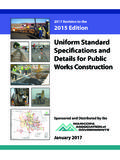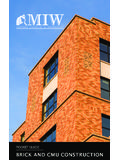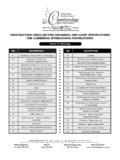Transcription of Introduction to Concrete - Portland Cement Association
1 CHAPTER 1 Introduction to ConcreteConcrete s versatility, durability, sustainability, and economy have made it the world s most widely usedconstruction material. About four tons of Concrete are produced per person per year worldwide and about per person in the United States. The term Concrete refers to a mixture of aggregates, usually sand, and eithergravel or crushed stone, held together by a binder of cementitious paste. The paste is typically made up ofportland Cement and water and may also contain supplementary cementing materials (SCMs), such as fly ash orslag Cement , and chemical admixtures (Figure 1-1).Understanding the fundamentals of Concrete is necessary to produce quality Concrete . This publication coversthe materials used in Concrete and the essentials required to design and control Concrete mixtures for a widevariety of components: Cement , water, coarseaggregate, fine aggregate, supplementary cementingmaterials, and chemical TrendsThe United States uses about 230 million cubic meters (300 million cubic yards) of ready mixed Concrete eachyear (Figure 1-2).
2 It is used in highways, streets, parking lots, parking garages, bridges, high-rise buildings,dams, homes, floors, sidewalks, driveways, and numerous other applications (Figure 1-3). Cement ConsumptionThe Cement industry is essential to the nation's construction industry (Figure 1-4). Few construction projects areviable without utilizing Cement -based products. The United States consumed million metric tons (95 millionshort tons) of Portland Cement in 2014. Cement production is dispersed with the operation of 91 cementplants in 33 states. The top five companies collectively operate around 59% of clinker capacity (PCA 2015).Figure mixed Concrete is conveniently delivered tojobsites in trucks with revolving and Control of Concrete Mixtures EB0012 Figure 1-5. Storage silos for cementat a manufacturing consumption varies based on the time of year and prevalent weather conditions.
3 Nearly two-thirds Cement consumption occurs in the six month period between May and October. The seasonal nature of theindustry can result in large swings in Cement and clinker (unfinished raw material) inventories at Cement plantsover the course of a year. Cement producers will typically build up inventories during the winter and then shipthem during the summer (Figure 1-5).The majority of Cement shipments are sent to ready-mixed Concrete producers (Figure 1-6). The remainder areshipped to manufacturers of Concrete related products, contractors, materials dealers, oil well/ mining/drillingcompanies, as well as government domestic Cement industry is regional in nature. The logistics of shipping Cement limits distribution over longdistances. As a result, customers traditionally purchase Cement from local sources. About 97% of Cement isshipped to customers by truck.
4 Barge and rail account for the remaining distribution is used as a building material in the applications listed in Table 1-1. Portland Cement consumption inthe United States by user groups is defined in Figure 1-7. The apparent use of Portland Cement by market isprovided for 2014 in Figure 1-8. The primary markets (Figure 1-9) are described further in the following pavements have been a mainstay of America s infrastructure since the 1920s. The country s firstconcrete street (built in Bellefontaine, Ohio, in 1891), is still in service today. Concrete can be used for newpavements, reconstruction, resurfacing, restoration, or rehabilitation. Concrete pavements generally provide thelongest life, least maintenance, and lowest life-cycle cost of all 1-3. Concrete is used as a building material for many applications including high-rise (left) andpavement (right) Cement manufacturing plant (Courtesyof GCC).
5 Chapter 1 Introduction to Concrete3 Water and wastemanagement9%Streets andhighways30%Utilities4%Other publicworks3% Non-construction( oil well)6%Farmconstruction4%Commercialbuild ings16%Publicbuildings2%Residentialbuild ings26%Figure 1-8. Apparent use of Portland Cement bymarket (PCA 2015).Figure 1-6. The majority of Cement is shipped to concreteproducers in Cement haulers (tankers).All * material & block/manufactured & gaswell &highways * Includes interlocking pavers , Fiber= Cement Siding, Waste S/S, SC/RCC Water Resources Figure 1-7. Portland Cement consumption in by usergroups (PCA 2015).Bridges Buildings Masonry Parking Lots Pavements Residential Transit and Rail Soil Cement and Roller-Compacted ConcreteWaste Remediation Water Resources Table and Applications for Concreteas a Building MaterialA variety of Cement -based products can be used in pavement applications including soil- Cement ,roller-compacted Concrete , cast-in place slabs, pervious Concrete , and whitetopping.
6 They all contain the threesame basic components of Portland Cement , soils/aggregates, and Concrete pavements are best known as the riding surface for interstate highways, Concrete is also adurable, economical and sustainable solution for rural roadways, residential and city streets, intersections,airstrips, intermodal facilities, military bases, parking lots and much than 70% of the bridges throughout the are constructed of Concrete . These bridges perform year-round in a wide variety of climates and geographic locations. With long life and low maintenance, concreteconsistently outperforms other materials as a choice for bridge construction. A popular method to acceleratebridge construction is to use prefabricated systems and elements. These are fabricated off-site or adjacent to theactual bridge site ahead of time, and then moved into place as needed, resulting in a shorter duration forconstruction.
7 These systems are constructed with Concrete reinforced, pretensioned, or post-tensioned (or acombination thereof). Engineered to meet specific needs, high-performance Concrete (HPC) is often used forbridge applications including: high-durability mixtures, high-strength mixtures, self-consolidating Concrete , andultra-high performance Concrete construction for high-rise buildings provides inherent stiffness, mass, and of Concrete towers are less likely to perceive building motions than occupants of comparable tallbuildings with non- Concrete structural systems. A major economic consideration in high-rise construction isreducing the floor to floor height. Using a reinforced Concrete flat plate system, the floor to floor height can beminimized while still providing high floor to ceiling heights. As a result, Concrete has become the material ofchoice for many tall, slender first reinforced Concrete high-rise was the 16-story Ingalls Building, completed in Cincinnati in 1903.
8 Greaterbuilding height became possible as Concrete strength increased. In the 1950s, 34 MPa (5000 psi) was consideredhigh strength; by 1990, two high-rise buildings were constructed in Seattle using Concrete with strengths of up to131 MPa (19,000 psi). Ultra-high-strength Concrete is now manufactured with strengths in excess of 150 MPa(21,750 psi).Slightly more than half of all low-rise buildings in the United States are constructed from Concrete . Designersselect Concrete for one-, two-, and three-story stores, restaurants, schools, hospitals, commercial warehouses,terminals, and industrial buildings because of its durability, excellent acoustic properties, inherent fireresistance, and ease of construction. In addition, Concrete is often the most economical choice: load-bearingconcrete exterior walls serve not only to enclose the buildings and keep out the elements, but they also carryroof, wind, and seismic loads, eliminating the need to erect separate systems.
9 Four Concrete constructionmethods are commonly used to create load-bearing walls for low-rise construction: tilt-up, precast, concretemasonry, and and Control of Concrete Mixtures EB0014 Figure s primary markets include: pavements, bridges, and high-rise and low-rise Beginning of an IndustryThe oldest Concrete discovered dates from around 7000 BC. It was found in 1985 when a Concrete floor wasuncovered during the construction of a road at Yiftah El in Galilee, Israel. It consisted of a lime Concrete , madefrom burning limestone to produce quicklime, which when mixed with water and stone, hardened to formconcrete (Brown 1996 and Auburn 2000).A cementing material was used between the stone blocks in the construction of the Great Pyramid at Giza inancient Egypt around 2500 BC. Some reports say it was a lime mortar while others say the cementing materialwas made from burnt gypsum.
10 By 500 BC, the art of making lime-based mortar arrived in ancient Greece. TheGreeks used lime-based materials as a binder between stone and brick and as a rendering material over porouslimestones commonly used in the construction of their temples and pozzolans have been used for centuries. The term pozzolan comes from a volcanic ash mined atPozzuoli, a village near Naples, Italy, following the 79 AD eruption of Mount Vesuvius. Sometime during thesecond century BC the Romans quarried a volcanic ash near Pozzuoli. Believing that the material was sand, theymixed it with lime and found the mixture to be much stronger than previously produced. This discovery was tohave a significant effect on construction. The material was not sand, but a fine volcanic ash containing silica andalumina. When combined chemically with lime, this material produced what became known as pozzolaniccement.








